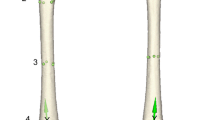Abstract
The sphericity of a limited area of the surface of the human femoral head has been assessed using the Talyrond roundness-measuring instrument. It is argued that this area approximates sufficiently closely to the load-bearing surface during standing and walking to allow conclusions to be drawn as to the sphericity of the whole head. The degree of sphericity is less than that reported byWalmsley (1928), but asphericity does frequently exist. The exis of any ovality is highly variable in this range of specimens, and the significance of this in relation to other published work is briefly discussed.
Sommaire
La sphéricité d'une partie limitée de la surface de la tête fémorale humaine a été évaluée à l'aide de l'instrument de mesure de rondeur de Talyrond. Il est débattu que cette partie se rapproche suffisemment de la surface porteuse pendant la position debout et la marche pour permettre de tirer des conclusions concernant la sphéricité de toute la tête. Le degré de sphéricité est plus faible que celui rapporté parWalmsley (1928), mais la non sphéricité est fréquente; l'axe de toute ovalité est très variable dans cette gamme de spécimens, et la signification de ceci en rapport à d'autres travaux publiés est discutée brièvement.
Zusammenfassung
Unter Verwendung des Rundungsmeßgeräts Talyrond wurde die Kugligkeit eines begrenzten Teils der Oberfläche des menschlichen Oberschenkelkopfes bestimmt. Es wird behauptet, daß diese Fläche der beim Stehen und Gehen lasttragenden Oberfläche ähnlich genug sei, um Schlußfolgerungen in bezug auf die Kugligkeit des ganzen Kopfes zuzulassen. Der Kugligkeitsgrad ist geringer als vonWalmsley (1928) angegeben, und oft tritt eine asphärische Form auf: Die Achse jedes ovalen Körpers ist in diesem Probenbereich sehr variabel, und es wird kurz erörtert, was das im Zusammenhang mit anderen veröffentlichten Arbeiten zu bedeuten hat.
Similar content being viewed by others
References
Bullough, P., Goodfellow, J., Greenwald, A. S. andO'Connor, J. (1968) Incongruent surfaces in the human hip joint.Nature 217, 1290.
Greenwald, A. S. (1970) Ph.D. thesis, Oxford. The transmission of forces through animal joints.
Hammond, B. T. andCharnley, J. (1967) The sphericity of the femoral head.Med. & Biol. Eng. 5, 445.
Swanson, S. A. V. andFreeman, M. A. R. (1970) InThe mechanics of synovial joints, Ed. Simpson, D. C. Butterworth, London.
Walker, P. S., Sikorski, J., Dowson, D., Longfield, M. D., Wright, V. andBuckley, T. (1969) Behaviour of synovial fluid on surfaces of articular cartilage: a scanning electron microscope study.Ann. Rheum. Dis.,28, 1.
Walmsley, T. (1928) The articular mechanism of the diarthroses.J. Bone & Joint Surg. 10, 40.
Author information
Authors and Affiliations
Rights and permissions
About this article
Cite this article
Blowers, D.H., Elson, R. & Korley, E. An investigation of the sphericity of the human femoral head. Med. & biol. Engng. 10, 762–775 (1972). https://doi.org/10.1007/BF02477387
Received:
Accepted:
Issue Date:
DOI: https://doi.org/10.1007/BF02477387




